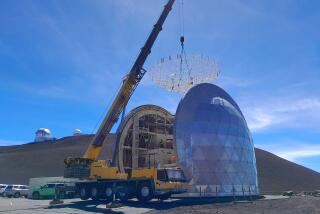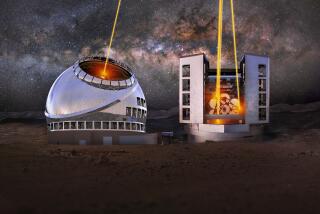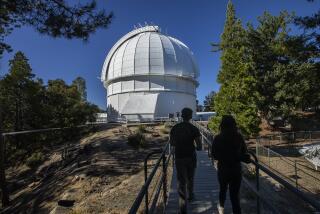Land Issue Could Derail Giant Telescope : Astronomy: A European consortium is at odds with descendants of a Chilean war hero over a perfect mountain spot for a huge telescope.
LA SILLA, Chile — A consortium of eight European countries envisioned an 8,635-foot mountain as an ideal site for what would be the world’s largest telescope.
In fact, the consortium believed it had the right to build the telescope under a 1963 treaty with Chile.
But the consortium has run into a snag: Descendants of a 19th-Century Chilean war hero say they have rights to part of the mountain and have gone to court to halt construction.
The European Southern Observatory, owned by the eight countries, wants to construct the 16-meter Very Large Telescope, VLT, on the mountain 75 miles south of Antofagasta. Chile donated the land on Cerro Paranal where the $500-million installation is planned.
The VLT would be an extension of the 14-telescope observatory the consortium already owns at La Silla, a 7,874-foot mountain about 310 miles south of Paranal on the southern edge of the Atacama Desert.
Descendants of Adm. Juan Latorre, who served Chile during the 19th-Century War of the Pacific against Peru and Bolivia, say they have rights to part of Paranal and filed suit to annul the land donation.
The European Southern Observatory, or ESO, contends that it received diplomatic immunity in its original 1963 La Silla agreement with Chile and wants the court to extend the immunity to Paranal.
After a three-week halt, a judge allowed site preparation to resume in April while considering the immunity issue. If immunity is not granted, the suit could drag on for years, jeopardizing the project, according to the consortium of Belgium, Denmark, France, Holland, Italy, Germany, Sweden and Switzerland.
The lawsuit is only the latest problem for ESO, which has been criticized by labor unions, Chilean astronomers and the Chilean Congress for its operation on La Silla.
The unions argue that the observatory should follow local laws for its Chilean employees.
Chilean astronomers demand a fixed amount of telescope time annually. Currently, they can use the telescopes only if their proposals are selected by a competition committee.
“Sometimes with ESO it was not clear why (a) proposal was rejected while other proposals of lesser quality were accepted,” said Hernan Quintana, an astronomy professor at Catholic University.
The observatory has claimed immunity from the labor laws and emphasized that Chile did not ask for guaranteed telescope time in the 1963 agreement.
A year ago, the Chilean government and ESO negotiated a supplementary agreement to address these issues, but it has yet to clear a critical Chilean Congress.
In May, observatory representatives and government officials met to modify the agreement. Neither side would provide details, but both called the meetings productive.
ESO is one of three international observatories built in the 1960s to take advantage of the clear nights and ideal observation conditions in Chile’s north-central region.
Cerro Tololo, 7,218 feet high with seven telescopes, is one of the United States’ National Optical Astronomy Observatories. Las Campanas, at the same altitude with three observatories, is operated by the Carnegie Institution, a Washington-based nonprofit foundation.
The Atacama Desert is the driest place on Earth, with little rain and few clouds to impair astronomic research. The observatories lose only about 30 nights annually to clouds. By contrast, European cloudy nights number 150 to 200 annually.
Like ESO, the other observatories are building bigger telescopes.
An 8-meter telescope is planned for Cerro Tololo and will be the twin of one being built in Mauna Kea, Hawaii. The two telescopes will be coordinated to view the entire sky simultaneously. The telescopes, costing $176 million, are funded by the United States, Britain, Canada, Chile, Brazil and Argentina. Construction of what is called the Gemini Project is expected to be completed by 2001.
Las Campanas has leveled one of its mountaintops to build a 6.5-meter telescope, costing between $35 million and $40 million. Miguel Roth, director at Las Campanas, said there is a 90% chance that a second telescope of the same size will be built.
More to Read
Sign up for Essential California
The most important California stories and recommendations in your inbox every morning.
You may occasionally receive promotional content from the Los Angeles Times.










